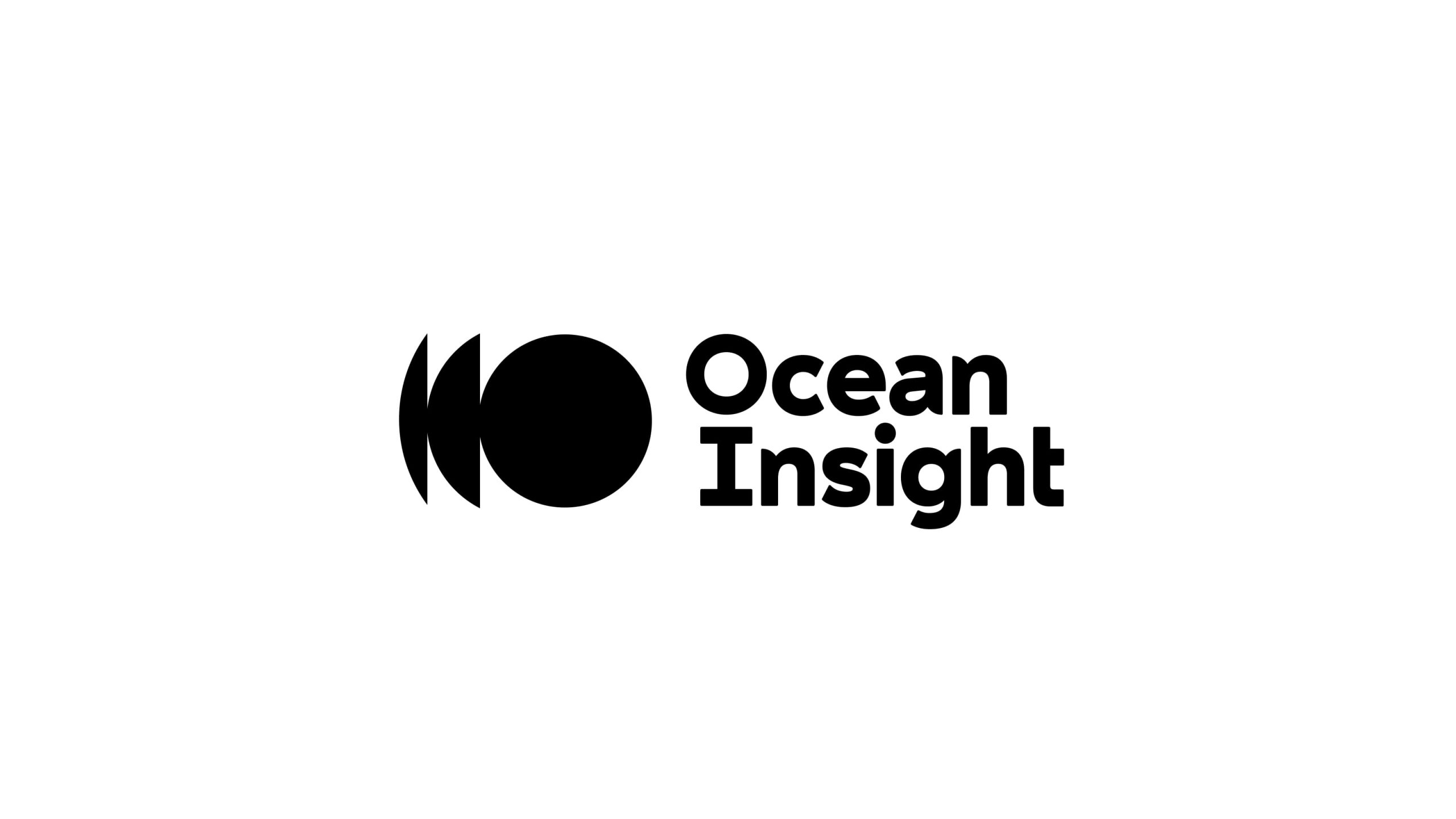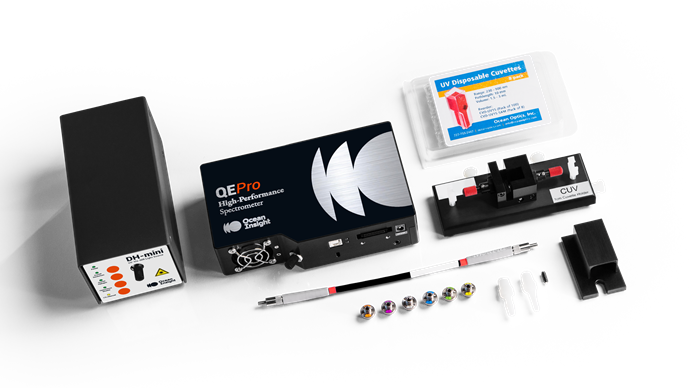By Ocean Insight
Ocean Insight Spectrophotometry Solutions
As a specialist in applied spectral knowledge, Ocean Insight can offer a range of measurement and analytical solutions based on the principles of spectrophotometry – quantification of chemical substances based on how much light they absorb, measured by using a spectrophotometer to pass a beam of light through a sample solution.
Spectrophotometry relies on the core understanding that each compound absorbs or transmits light over a certain wavelength range. This knowledge can be applied to measure concentrations or amounts of chemical substances, making spectrophotometry highly useful for quantitative analysis in various fields such as chemistry, physics, biochemistry, material and chemical engineering, and clinical applications. In biochemistry, for example, spectrophotometry can be used to determine enzyme-catalyzed reactions and in medicine can be used for clinical diagnosis of blood or tissue samples.
Spectrometer vs. spectrophotometer
Terms like spectroscopy, spectrometry and spectrophotometry, as well as spectrometer and spectrophotometer, are often used interchangeably, although each connotes something slightly different. In this article, our focus is on spectrometers and spectrophotometers, which are analytical instruments.
- Spectrometer: A spectrometeris a spectroscope (collects light and disperse it in a spectrum) with a detector so it can measure the amount of light (number of photons) at specific wavelengths. It is designed to provide a quantitative measure of the amount of light emitted or absorbed at a wavelength. Ocean Insight spectrometers have a fixed light-dispersing element (e.g., diffraction grating) that disperses multiple wavelengths of light onto a multi-element detector. Using a spectrometer, it is possible to measure which wavelengths of light are present and in what relative amounts.
- Spectrophotometer: A spectrometer that includes a light source is known as a spectrophotometer. It is constructed so that the sample to be studied can be irradiated with light. A traditional spectrophotometer consists of a light source, a collimator (lens) to transmit the light beam, a monochromator (prism) to break up the beam into component wavelengths, a wavelength selector (grating) to pass only the desired wavelengths, a detector, the spectrophotometer cuvette to contain the sample solution, and a digital display or a meter.
Spectrophotometer types
Some spectrophotometers have the components hidden from view — i.e., they are presented as a single, all-in-one instrument designed specifically for one kind of measurement. These are the traditional benchtop models familiar to labs in many settings.
Other spectrophotometer systems are made from modular parts. For example, Ocean Insight offers product lines designed to use optical fibers to connect the various components into functional systems. In modular systems, the components are easy to see, and are selected and specified by the user. In this context, “spectrophotometer” describes a combination of components including a spectrometer, light source and sampling optic (fiber, probe, cuvette holder and so on).
The most widely used spectrophotometry options are UV-visible or UV-vis spectrophotometers and near infrared (NIR) spectrophotometers. For example, Ocean Insight offers a UV-vis system for educational labs called the FLAME-CHEM. Other variants include atomic absorption spectrophotometers and atomic emission spectrophotometers.
Depending on the wavelength range, light can be classified into two different types:
Light over the ultraviolet range (<400 nm) and visible range (400-700 nm) of the electromagnetic radiation spectrum, which determines the wavelength range of UV-visible spectrophotometers.
Light over the near infrared (NIR) or infrared (IR) range extending from 700 nm all the way up to 15000 nm, as used by NIR or IR spectrophotometers.
A visible spectrophotometer can also be thought of as a color spectrophotometer because it can determine absorption or transmission of substances by observed colors. So, a solution that absorbed all visible light would appear black while one that absorbed no light would appear clear (white). In practice, the color displayed tells the laboratory which wavelengths are being absorbed, so a solution that absorbed light on the red spectrum around 700 nm will appear green. Traditional visible spectrophotometers use a monochromator to filter the light to a selected wavelength to provide more precise measurements.
Spectrophotometer measurements
When looking at spectrophotometer uses, we observe that absorbance is among the most common measurements.
Absorbance is the part of the light that cannot pass through the sample at certain wavelengths.
Absorbance increases with concentration in a solution and can be plotted on the spectrophotometer calibration curve (even though the relationships are essentially linear).
When the total absorbance of the sample does not change during a chemical reaction or physical change of the sample, the measurement has reached the isosbestic point. Isosbestic points are useful as reference points in studying reaction rates and as part of QA methods to verify spectrophotometer accuracy.
Transmittance is the fraction of photons that passes through the sample. This is a function of the length of the spectrophotometer cuvette and the concentration of the sample (as expressed in Beer’s Law). Measurement of light intensity passing through the cuvette can then be calculated into a transmittance value (T) and therefore, absorbance (A).
With these values determined by the absorbance spectrophotometer (or an absorbance spectrometer), the sample concentration can be calculated using the Beer-Lambert Law. Beer’s Law describes the linear relationship between the absorbance and the concentration, molar absorption coefficient and optical coefficient of a solution (A=ϵlc).
Every absorbance application of a spectrophotometer relies on Beer’s Law to be able to calculate any of these variables, once other values are known.
Ocean Insight spectrophotometry solutions
Modular, small-footprint spectrophotometer systems can be configured for a variety of measurements. Among potential applications are chemical dissolution and ingredients analysis for pharmaceuticals; color and appearance of food and plastics; and soil and groundwater contamination analysis. Coupling spectrometers to optical oxygen sensors adds another layer of possibilities, with headspace analysis and shelf life studies among the likely pharmaceutical applications.
In life sciences, Ocean Insight provides the spectrophotometric instrumentation and application insights needed to meet the growing demand for faster, more accurate diagnostic tools and simpler, smarter and more robust solutions that pharmaceutical and life sciences professionals need to deal with health issues associated with aging populations and developing markets.
From monitoring trace amounts of chemicals to evaluating colorimetric assays, Ocean Insight spectrophotometric tools ensure accuracy and traceability with quantitative measurements.

















